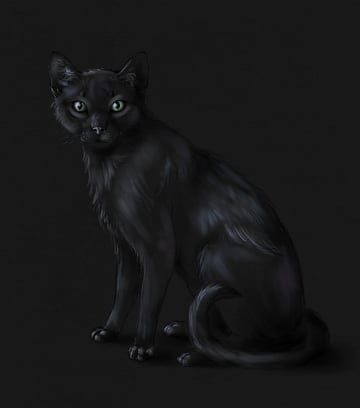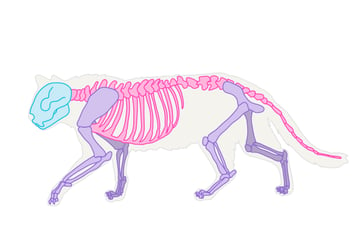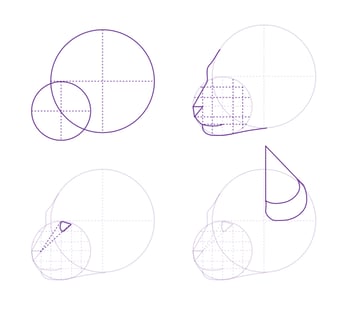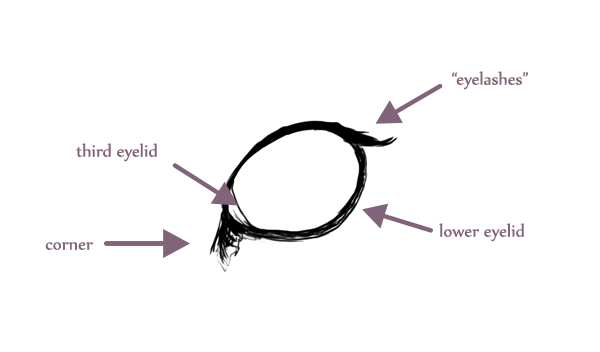How To Draw A Cat Body Step By Step



Cats rule the Internet! No doubt one day they'll take complete control over our lives. To prepare for this day we need to know the enemy. By drawing a cat you'll understand what they really are made of. So, grab a pencil and I'll show you what cats are made of!
If you want some references to work from, you can find plenty of cat photos over on Envato Market. Just make sure that you don't get too distracted by all that cuteness, and remember to come back and finish the tutorial!
1. The Cat Skeleton Structure
Step 1
Learning a skeletal structure is the first step to create a believable pose. Bones are a support for muscles, and joints between them define the range of motion.



Step 2
Luckily, you don't need to remember the exact shape of bones. You just need to know how long they are and how they're connected to each other. The good news is, most four-legged animals have the same bone structure, with bones length and distance between them being the only differences. Learn it once and you're set forever!
You should remember your skeleton as a group of ovals (joints, skull, chest, hips) and lines (bones, backbone). Once you've remembered this structure, you can easily draw every pose.



Step 3
There's one more thing you need to remember; every joint has a specified range of motion. When you break their limits, your animal will look broken. To understand it, take a good look at this run animation. While running, a cat uses a full range of motion, so you can see which movements are natural.



What you should observe:
- The jump is starting; hind legs push the ground back.
- As the hind legs recede, the forelegs go forward.
- When legs push the ground, the part of body they're attached to stays on default level. The other one can go up.
- Notice that the hind legs' bones never make a straight line, even when fully expanded.
- It's flying! No leg on the ground, body fully expanded.
- Forelegs are preparing to land as far as possible.
- Forelegs are fully expanded now, and again - no straight line.
- Again, see the levels difference.
- Landing done; hind legs will try now to land in the same point.
- Pay attention to this point; it can't move without dragging the whole chest with it.
- The tail's root direction is based on the hip's pose.
- When all the paws are on the ground, front and rear stay at the same level.



If you want to take a better look at the running cycle, here's a great reference: a video of cheetah in slow motion.
Step 4
You may say "I don't need it, I can feel the proper pose". Well, maybe, but there are a few mistakes a lot of people do by simple ignorance.
This is a very popular interpretation of an animal's skeleton. It comes from confusing the hind and the forelegs. They are not the same! Just compare your hands and feet.



Well, this pose isn't universally wrong - it'll work quite well in cartoons, where the characters use their legs as propellers. In real world though, the hind legs reach at most 120 degrees rotation (even as cheetahs). Also, the cat will try to keep its head on the same position while running; unless it's some mad zombie-cat (check the animation again for the proof).



Wow, that's some interesting skeleton! It comes from adapting the bones purely into the cat's thigh shape. The problem is it's not only bones that make the thigh shape - it's mostly muscles, and you can't ignore that. Also, the first pose has crouching foreleg and sitting hind leg. Small cats eat in this pose, but their chest isn't on the ground then.



Another problem comes from a weird habit of cats. They use a "pacing" gait when walking - they move two legs from one side first, and then two legs from the other side. This mistake will not be noticed by most of people, but hey, it's still a mistake! Luckily, cats change to "diagonal" gait when speeding up.



Step 5
Once you've learned everything about building a pose, sketch your own.



2. The Cat Muscle Structure
Step 1
Muscles give shape to the body. You can draw a body without knowing the muscle structure, but guessing is not the best way to go about it. You may think it's too complicated to learn, but I can show it's not that hard.
First, cover your pose with simplified muscle masses. Yes, it's that easy! If your cat is going to be very furry, it's actually all you need. Muscles won't show anyway.



Step 2
That's my cat covered with basic muscle masses.



Step 3
Those of us who prefer short or medium haired cats need to learn some more. Still, it can be simplified too. These are big masses that can be visible under the skin. If you want to learn it painlessly, just use this reference for the start. After a few exercises this structure will sink in itself.



Step 4
Now my cat has muscles too!



Step 5
For the end, there's one more thing. Cats have quite loose skin; in some areas it's not used to cover the muscles. If you have a cat, try to touch the area between the thigh and the calf - you'll feel only skin and fur! Thanks to this additional skin you can't see the thigh or calf when a cat is sitting.



Step 6
Draw the additional skin too to complete the body shape.



3. How to Draw Cat Paws
Step 1
Cat hind and forepaws are different, just like your hands and feet. You can use them to imagine a paw structure. Cats walk on their fingertips, using just a part of the "palm" for a support. They also have a little thumb (dew claw) and a small appendix on the wrist (pisiform), but only on forepaws. The hind paws are actually very similar to our feet.



Step 2
Cat paws are totally unique in the animal world. Their claws are retractable, but it doesn't really work like most of us imagine it. A claw is attached to the last bone of a finger. Surprisingly, this part is placed next to the previous bone, not to the end of it. Only when it's retracted, it comes closely to the end.
What does it mean for us? The claws, including the little bones they're attached to, are placed at the outer side of every finger. It means they're not symmetrical. If the illustration below confuses you, check out photos of sphinx cats, as they have "no fur", the claws are more visible.
From viewing these, you can easily see why declawing is a controversial issue.



Step 3
Here we have left and right fore paw, both with claws retracted. Try to do the same position with your hand to learn where the forearm ends and where the paw starts.



Step 4
Let's learn how to draw a paw then.
- For the front view: draw four lines ending in a "stone" shape.
- For the side view: draw four lines starting in an oval, then draw a step at the end of each. The steps in the middle should be slanting.



Step 5
- For the front view: draw four "eggs" at the end of the lines, within the stone shape.
- For the side view: draw four "eggs" to cover the last angle. Connect the eggs with the first part of the lines



Step 6
You may need to add the pisiform (outer view) or the dew claw (inner view), if you're drawing the forepaws.



Step 7
Now cover whole shape with fur. The claws have their special, thin coat, covering them only on top and sides.



Step 8
OK, those were fluffy, soft paws. What about Paws à la Angry Kitty? They're easy too once you've known the anatomy.



Step 9
Now my cat has complete paws.



4. How to Draw Cat Face Proportions
Cat facial proportions differ among breeds, but there are rules you can use for a "typical" cat.
Step 1
Draw two circles, one big and one smaller. This is a rough shape of the head and a muzzle.



Step 2
Divide the smaller circle into six rough, equal parts.



Step 3
Divide the middle line onto six equal parts. It will help us find the right place for the nose and mouth.



Step 4
Put a simple triangle between the lines shown below. You can also start the mouth.



Step 5
Draw the rest of the muzzle using the lines as landmarks.



Step 6
Now we're going to set a place for the eyes. Add four guides using already established lines.



Step 7
You can now easily add the eyes.



Step 8
When you want to draw a kitten, you need to change the proportions a bit to get bigger, round eyes.



Step 9
To complete the head shape add ears and structure for the cheeks.



Step 10
Drawing a head from profile isn't really hard once you've known how to place guide lines.



Step 11
So now we know how to draw the head of a cat, but it's still just a base for a real drawing. In next steps we'll take care of every single element of a cat's face.



5. How to Draw a Cat's Eye
Step 1
If you followed my previous tips, you should have an oval/circle as an eye base.



Step 2
We can see three elements around the eye - a lower eyelid's edge, an upper eyelashes row, and a dark area in the inner corner. Part of third eyelid can be shown too.



Step 3
Add a pupil:
- Small cats have slit pupils; they're round only in weak light.
- Big cats have rounded pupils; in strong light they only get smaller, not narrower.
The size of the pupils can be important for a picture's authenticity. If you draw a cat with a big, round pupils, and it's on a sunny beach (or in front of fire), it will look unnatural.



Step 4
Add dark "veins" around the pupils and lighter ones everywhere else, branching off radially from the center of the eye.



Step 5
It's not only the eyeball that makes the eye. If you'd draw a human face, you'd add eyelids, eyelashes and probably eyebrows too, to make it more complete. For a cat eye we can add a lighter areas around it, and also a dark, narrow ellipse over the eye - it's a place where a few whiskers come out from.



Step 6
When the eye is closed, it becomes a dark line. Both light areas around it get closer too.



Step 7
The side view may be a little tricky. From this view a transparent dome of the lens is visible, and the rest of the eye seems flat (try looking at photos of cats to see this).



Step 8
Once you've know how eyes should look, you can add them to the face.



6. How to Draw a Cat's Nose
Step 1
Start with a long diamond. Its bottom is usually darker.



Step 2
Add two "wings" for the nostrils.



Step 3
Draw the holes. They're not similar to human inner nostrils, so be careful here.



Step 4
Add the nose bridge. It should be round on top. Also the sides of this bridge will be slightly darker and the fur will be a lot shorter.



Step 5
Our kitty has now got its cute nose!



7. How to Draw Cat Ears
Step 1
Cat ears are not really as simple as we would think. They're not just triangles or even cones - they're a complicated structure that you will need to learn, in order to make your drawings more realistic.



Step 2
To draw an ear from the front, start with a circle. Then divide it into four parts, drawing the lines at a small angle.



Step 3
Use the guides to draw the outlines of the ear.



Step 4
Cats have a weird fold on the outer side of their ears, called a "tragus". It's quite hard to draw from the front, but it's necessary - draw it and people will think you're a cat expert!



Step 5
Now you can add hair tufts. Their amount will depend on the breed, but generally it's best to attach them to the inner side and leave the outer part bare.



Step 6
But hey, there's more! Cats can rotate their ears, so what about other "poses"? You can use the same method for them. Just keep in mind that ears are bigger than what we usually see. You can cover this bottom part with soft fur. If you compare the ears of long hair vs "no hair" cats, you'll see what a difference fur makes in terms of how large the ears appear.



Step 7
Our cat can now hear!



8. How to Draw Cat Whiskers
Step 1
Whiskers are a cat's additional sense. They have them on their mouths, above the eyes, under the chin and behind the paws. Whiskers grow out of little, dark "holes" in fur. We've already drawn the "whisker spots" above the eyes, now add some little ones on the muzzle.



Step 2
Generally, cats have twelve whiskers on every side, but you don't need to stick to this number. Thirteen on the left and fifteen on the right is OK too! Just keep them very thin and light. They also should be longer than the half of a head.



9. How to Draw Cat Fur
Step 1
The amount of fur determines the shape of the head. A cat head without fur is triangular. Then, when some short fur is added, its shape softens. Add longer fur and the head will become round (also, kittens look more cute/younger with round heads). When you add extremely long fur, the head becomes a trapeze.



Step 2
Also, the shape of the body depends on the length of fur. Short or flat-laying fur will accent the slim body of a cat, while long, thick fur will make the silhouette bigger. Always start with a slim body when you're drawing a cat, and add the fur later, changing the silhouette to your needs.






Purrfect Job, Well Done!
Great work, you know everything about their skeleton and muscles, and all the rules that make cats, cats! Now you know the enemy, you can create your own cat creations.
How To Draw A Cat Body Step By Step
Source: https://design.tutsplus.com/articles/how-to-draw-animals-cats-and-their-anatomy--vector-17417
Posted by: patelstemed1965.blogspot.com

0 Response to "How To Draw A Cat Body Step By Step"
Post a Comment